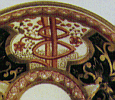Menu

Home Calligraphy Trip to Beijing Focus on Japan Zen Belleza Odiada ConnectedGlobe
To see this page in your own language use the following translation bar.
 The characteristics of the pattern are the two almond shaped circles depicted with the two vertical
lines. It seems to me that the circles signify either roots or branches.
The characteristics of the pattern are the two almond shaped circles depicted with the two vertical
lines. It seems to me that the circles signify either roots or branches.
 If they were roots, it is possible to view this as a degenerate Root Pattern, the original of which
depicts a flowering prunus tree with gnarled and twisted roots. Root Pattern is one of the most
popular patterns copied by European and it is often found in examples of porcelain at Worcester.
If they were roots, it is possible to view this as a degenerate Root Pattern, the original of which
depicts a flowering prunus tree with gnarled and twisted roots. Root Pattern is one of the most
popular patterns copied by European and it is often found in examples of porcelain at Worcester.
Another important point relating to the investigation of the origin of the pattern is its whole
composition. The "Dollar Pattern" is always depicted in a kind of Cartouche or segmented area.
This composition is probably derived from KRAAK porcelain which was exported to Europe from
China in the 17th century and became very popular.
 When the Chinese ceramic industry declined owing to the civil war in the middle of 17th century,
the Dutch East India Company found its alternative in Japan. Therefore the Japanese version of
KRAAK porcelain was produced and exported to the West like this example you can find in
V&A museum in London now.
When the Chinese ceramic industry declined owing to the civil war in the middle of 17th century,
the Dutch East India Company found its alternative in Japan. Therefore the Japanese version of
KRAAK porcelain was produced and exported to the West like this example you can find in
V&A museum in London now.
 The strangest characteristic of the so-called "Dollar Pattern" is found in an unrealistic
representation of the three dimensional space around the two circles. The bigger, lower circle is
pierced by a vertical line (trunk), but the vertical line continues upwards without piercing the other,
smaller circle above. The other vertical line is depicted behind the two circles without piercing
them. This has a slightly surreal quality.
The strangest characteristic of the so-called "Dollar Pattern" is found in an unrealistic
representation of the three dimensional space around the two circles. The bigger, lower circle is
pierced by a vertical line (trunk), but the vertical line continues upwards without piercing the other,
smaller circle above. The other vertical line is depicted behind the two circles without piercing
them. This has a slightly surreal quality.
 The pattern in the Japanese KRAKK porcelain also shows an unrealistic representation in the two
circles. The trunk piercing the bottom circle disappears in the upper circle and reappears on the
top of the circle. Here too we see another departure from reality. These unrealistic points
might be the result of a misunderstanding when copying from Chinese originals.
The pattern in the Japanese KRAKK porcelain also shows an unrealistic representation in the two
circles. The trunk piercing the bottom circle disappears in the upper circle and reappears on the
top of the circle. Here too we see another departure from reality. These unrealistic points
might be the result of a misunderstanding when copying from Chinese originals.
 There can be also another interpretation of the two circles as a depiction of branches.
There can be also another interpretation of the two circles as a depiction of branches.
In Chinese porcelain, there are original examples of patterns existing in which the branches of a tree form a
Chinese character representing something auspicious like longevity or happiness. It is
possible that the craftsman in the Spode factory had seen a Chinese pattern of this kind in which
the tree branches formed a character. He would have had no idea what the character meant.
However, he would notice it was forming a character anyway and he tried to apply this kind of
representation for his work. He tried to depict something like a letter. The effect still works for us.
It looks like a letter and for our contemporary eyes the nearest equivalent is the US dollar symbol.

© 2019 Graham G Hawker
Privacy Policy